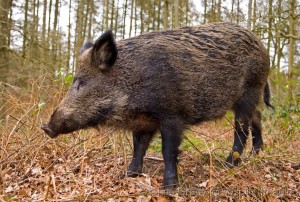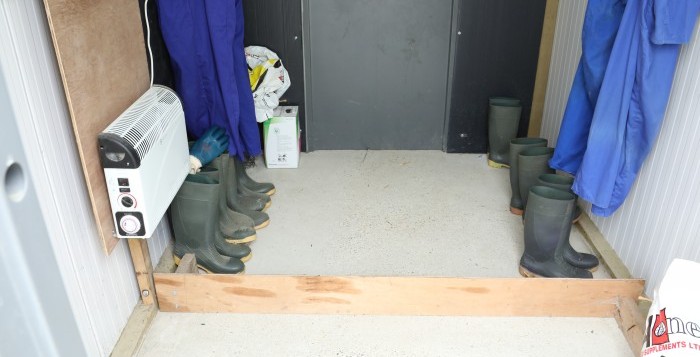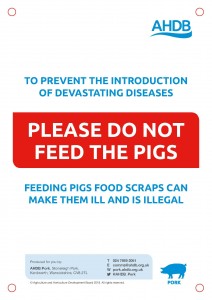High-health protocols of the sort in place at PIC nucleus units can be adapted to protect against disease on all units, as visitors to an AHDB pig club found out
Pig producers can often do more than they think to help keep out disease, on both indoor and outdoor farms.
At AHDB’s winter pig clubs, organised by knowledge exchange manager Pat Loten, producers were given a full insight into the protocols used on a high-health PIC nucleus unit, as well as ideas on how they could be adapted to suit their own situations.
Most high-health unit measures can be adapted to help protect commercial units, creating versions that work within their own routines and facilities, explained PIC key account manager, Nick Butler, and NPA chief policy adviser Rebecca Veale.
African swine fever (ASF) is still looming in Europe and there has been an increase in swine dysentery cases at home, which can often be triggered by colder weather.
While producers naturally tighten up their biosecurity in the event of a major disease outbreak, there should be a continual review process to minimise outbreaks in the first place, said Ms Veale.
Understanding the health status of any unit supplying pigs is critical in limiting the direct risk of introducing disease. There are also many indirect risks to consider, including vehicles, people, mobile phones and equipment.
PIC recommends not taking mobile phones onto units as they could be a high biosecurity risk. Mr Butler asked attendees to look underneath their phone covers as an example.
“You may well find straw or dust under there. If you need to take your phone onto the unit, using a disinfectant wipe to clean it first only takes a couple of minutes,” he said.
Clean, intermediate and dirty areas

“Establishing a unit’s perimeter and lines of separation between clean and dirty areas should form the basis of every pig unit’s protocol,” Mr Butler added (see main pic for an example).
The clean areas include the pig accommodation and all equipment used in there, while the dirty area comprises everything outside that, including quarantine areas.
PIC also defines the important ‘intermediate’ areas, for example the shower, boot rooms, decontamination chamber and mortality removal area.
On high-health indoor units, a perimeter fence creates a compound with shower facilities at the entry point and pressure-sealed doors and virus facilities.
“A commercial unit can’t go to this extent, but they can create clear areas in a boot room or shower area for dirty and clean footwear, ideally using the ‘Danish bench system’,” said Mr Butler.
The Danish bench, also known as a ‘dry shower’ system, involves placing a bench across the middle of the room or hut so that all staff and visitors sit on it before removing their footwear, then swinging their legs over to the other side without touching the floor and putting on the unit’s clean boots before leaving the room via a different door.
Ms Veale pointed out that on an outdoor unit you can put a plank of wood as a physical barrier across the floor of a personal protective equipment (PPE) hut as a cost-effective and sensible solution.
Training and signage
Clean and dirty areas should be explained to staff and visitors entering any unit and be clearly marked by signage. At PIC, there are detailed, pre-defined protocols and everyone is required to watch three training videos before entering a nucleus unit.
A separate eating area, with somewhere to wash hands, and signage explaining why not to bring any pork products on to the unit, is key to minimise the risk of ASF. Producers should make signs prominent, including on the lunch fridge. “Staff shouldn’t wander around the farm or drive the tractor eating lunch,” said Ms Veale.
A gate at the entrance to an outdoor pig site is an important physical barrier for both visitors and the public. “Even a few temporary hurdles are effective, but it is important to make sure gates are kept closed whenever they’re not being used,” said Ms Veale.
‘No entry’ signage and signs telling the public not to feed pigs is also vital, particularly when there are footpaths next to the unit. Free signs are available to order via the AHDB website or your regional AHDB knowledge exchange manager.
Ms Veale added: “We need multiple layers of control. It is worth moving signs and reminders around from time to time, so people still notice them. If there’s a staff change, make sure all new starters receive the same training or briefings.”
On arrival
There is a specified downtime or pig-free period for visitors to PIC nucleus units, which have a farm visit approval app that goes through several checks beforehand.
On arrival, checks and procedures include vehicle cleanliness and disinfection, footwear, showering for a minimum of three minutes, checking temperature and checking for any other flu-like symptoms, something that is commonly missed in pig unit biosecurity protocols.
Visitors should sign in and out of units using a visitors’ book and be provided with clean PPE. There is a useful template for visitor books on the Red Tractor website under ‘policy templates’.
A simple biosecurity measure for anyone visiting pig units is to put on disposable shoe covers before they get out of their vehicle, this will cut the risk of disease transmission via footwells – a supply of shoe covers can be kept in the car door. Some producers use video calling to avoid anyone visiting their unit apart from the vet.
Showers are not possible on every unit, but could potentially be done in a central place on both indoor and outdoor units. Importantly, showers must be cleaned regularly.
Some producers employ a cleaner to clean communal areas, including the office and shower areas, or cleaning could be done by unit staff on a rota basis, Ms Veale suggested.
“It can be easy to let things slide, so it’s important to review risks monthly and make sure everyone understands protocols and why they’re in place,” she said. “Have a standard checklist, with responsibility shared and passed around the team, which also provides a fresh pair of eyes each time.”
On outdoor units, producers need to consider nearby laybys, car parks and footpaths where rubbish may be left. Ms Veale shared an example of a unit which had put a wildflower margin between the footpath and pig fence to create distance.
Supplies and contractors
Before entering PIC nucleus units, all equipment and supplies go through a decontamination chamber. Items are placed on wire racks in UV light for a defined period or fogged with an approved disinfectant and allowed to fully dry.
Producers should make sure biosecurity protocols are applied to the tools and equipment of maintenance contractors such as electricians. “If it’s a specialist farm service, this is particularly important to make sure they’re not bringing disease in from another pig unit,” said Mr Butler.
Many diseases can be transmitted via the air, but this can be limited by keeping deliveries at a distance. For example, PIC makes AI deliveries into a small, insulated shed with a fridge inside, about a mile away from its high-health units.
Consistency is key
Often, the most important thing pig unit staff can do is to stick to protocols. Vet Richard Pearson, attending one of the meetings, said disease risk is cumulative and therefore it is important to address the most common, frequently occurring risks – for example, staff entering the unit each day, feed deliveries and pig wagons.
The same fundamental biosecurity routines will help protect against most health risks, from endemic enzootic pneumonia (EP) to exotic diseases like ASF and foot-and-mouth disease.
Main priorities
Mr Butler suggested the following basic principles that can make a big difference on every farm:
- Defining clean and dirty lines
- Using the Danish bench system
- Minimising cross-contamination from visitors going to other farms
- Training of staff and visitors.
Wild boar and ASF
 The spread of ASF has followed wild boar populations in Europe and spilled over into commercial herds.
The spread of ASF has followed wild boar populations in Europe and spilled over into commercial herds.
The Forest of Dean is the UK’s main focus for wild boar, and the authorities are having some success in controlling wild boar numbers. A major challenge is the proximity of the public, with a high number of tourists and campsites in the area.
Explaining to the public why they should not import pork products or allow pigs or wild boar to eat food leftovers is key. There is a joint industry effort underway to get these messages across from organisations including AHDB, NPA, APHA, and PVS – with a new #ASFstopthespread campaign coming up this year.
- See ahdb.org.uk/knowledge-library/african-swine-fever for more information and resources.






